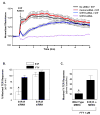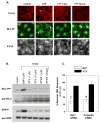Pulmonary endothelial cell barrier enhancement by FTY720 does not require the S1P1 receptor
- PMID: 17475445
- PMCID: PMC2682440
- DOI: 10.1016/j.cellsig.2007.03.011
Pulmonary endothelial cell barrier enhancement by FTY720 does not require the S1P1 receptor
Abstract
Novel therapeutic strategies are needed to reverse the loss of endothelial cell (EC) barrier integrity that occurs during inflammatory disease states such as acute lung injury. We previously demonstrated potent EC barrier augmentation in vivo and in vitro by the platelet-derived phospholipid, sphingosine 1-phosphate (S1P) via ligation of the S1P1 receptor. The S1P analogue, FTY720, similarly exerts barrier-protective vascular effects via presumed S1P1 receptor ligation. We examined the role of the S1P1 receptor in sphingolipid-mediated human lung EC barrier enhancement. Both S1P and FTY-induced sustained, dose-dependent barrier enhancement, reflected by increases in transendothelial electrical resistance (TER), which was abolished by pertussis toxin indicating Gi-coupled receptor activation. FTY-mediated increases in TER exhibited significantly delayed onset and intensity relative to the S1P response. Reduction of S1P1R expression (via siRNA) attenuated S1P-induced TER elevations whereas the TER response to FTY was unaffected. Both S1P and FTY rapidly (within 5 min) induced S1P1R accumulation in membrane lipid rafts, but only S1P stimulated S1P1R phosphorylation on threonine residues. Inhibition of PI3 kinase activity attenuated S1P-mediated TER increases but failed to alter FTY-induced TER elevation. Finally, S1P, but not FTY, induced significant myosin light chain phosphorylation and dramatic actin cytoskeletal rearrangement whereas reduced expression of the cytoskeletal effectors, Rac1 and cortactin (via siRNA), attenuated S1P-, but not FTY-induced TER elevations. These results mechanistically characterize pulmonary vascular barrier regulation by FTY720, suggesting a novel barrier-enhancing pathway for modulating vascular permeability.
Figures








Similar articles
-
Junctional complex and focal adhesion rearrangement mediates pulmonary endothelial barrier enhancement by FTY720 S-phosphonate.Microvasc Res. 2015 May;99:102-9. doi: 10.1016/j.mvr.2015.03.007. Epub 2015 Apr 7. Microvasc Res. 2015. PMID: 25862132 Free PMC article.
-
Activated protein C mediates novel lung endothelial barrier enhancement: role of sphingosine 1-phosphate receptor transactivation.J Biol Chem. 2005 Apr 29;280(17):17286-93. doi: 10.1074/jbc.M412427200. Epub 2005 Feb 14. J Biol Chem. 2005. PMID: 15710622
-
Differential involvement of ezrin/radixin/moesin proteins in sphingosine 1-phosphate-induced human pulmonary endothelial cell barrier enhancement.Cell Signal. 2011 Dec;23(12):2086-96. doi: 10.1016/j.cellsig.2011.08.003. Epub 2011 Aug 12. Cell Signal. 2011. PMID: 21864676 Free PMC article.
-
Sphingosine-1-phosphate, FTY720, and sphingosine-1-phosphate receptors in the pathobiology of acute lung injury.Am J Respir Cell Mol Biol. 2013 Jul;49(1):6-17. doi: 10.1165/rcmb.2012-0411TR. Am J Respir Cell Mol Biol. 2013. PMID: 23449739 Free PMC article. Review.
-
FTY720: sphingosine 1-phosphate receptor-1 in the control of lymphocyte egress and endothelial barrier function.Am J Transplant. 2004 Jul;4(7):1019-25. doi: 10.1111/j.1600-6143.2004.00476.x. Am J Transplant. 2004. PMID: 15196057 Review.
Cited by
-
Role of the lysophospholipid mediators lysophosphatidic acid and sphingosine 1-phosphate in lung fibrosis.Proc Am Thorac Soc. 2012 Jul;9(3):102-10. doi: 10.1513/pats.201201-005AW. Proc Am Thorac Soc. 2012. PMID: 22802282 Free PMC article. Review.
-
Sphingolipids Signaling in Lamellipodia Formation and Enhancement of Endothelial Barrier Function.Curr Top Membr. 2018;82:1-31. doi: 10.1016/bs.ctm.2018.08.007. Epub 2018 Sep 27. Curr Top Membr. 2018. PMID: 30360778 Free PMC article.
-
Cortical Actin Dynamics in Endothelial Permeability.Curr Top Membr. 2018;82:141-195. doi: 10.1016/bs.ctm.2018.09.003. Epub 2018 Oct 15. Curr Top Membr. 2018. PMID: 30360779 Free PMC article.
-
Sphingosine-1-phosphate receptor-independent lung endothelial cell barrier disruption induced by FTY720 regioisomers.Pulm Circ. 2020 Feb 10;10(1):10.1177_2045894020905521. doi: 10.1177/2045894020905521. eCollection 2020 Jan-Mar. Pulm Circ. 2020. PMID: 32095229 Free PMC article.
-
FTY720 and SEW2871 reverse the inhibitory effect of S1P on natural killer cell mediated lysis of K562 tumor cells and dendritic cells but not on cytokine release.Cancer Immunol Immunother. 2010 Apr;59(4):575-86. doi: 10.1007/s00262-009-0775-7. Epub 2009 Oct 13. Cancer Immunol Immunother. 2010. PMID: 19823820 Free PMC article.
References
-
- Dudek SM, Garcia JGJ. Appl Physiol. 2001;91(4):1487–1500. - PubMed
-
- Shikata Y, Birukov KG, Garcia JG. J Appl Physiol. 2003;94(3):1193–1203. - PubMed
-
- Dudek SM, Jacobson JR, Chiang ET, Birukov KG, Wang P, Zhan X, Garcia JG. J Biol Chem. 2004;279(23):24692–24700. - PubMed
-
- McVerry BJ, Peng X, Hassoun PM, Sammani S, Simon BA, Garcia JG. Am J Respir Crit Care Med. 2004;170(9):987–993. - PubMed
Publication types
MeSH terms
Substances
Grants and funding
LinkOut - more resources
Full Text Sources
Other Literature Sources
Research Materials

